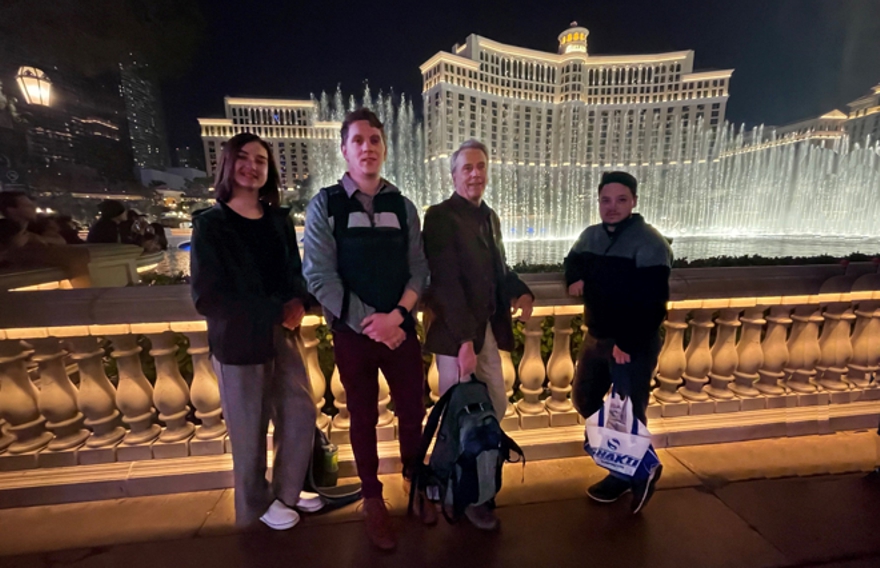
| Homepage | Research | Publications | Software | Teaching | Prospective Students | KU Hydrogeology |
Page Contents
- Introduction
- Measurement of groundwater flux in fractured media
- Moniroring flow in a passive treatment system
- Groundwater-surface water interaction research
- Granular iron research
- Direct measurement of groundwater velocity
- In situ denitrification
- Research Highlights
- Projects at a glance
Research Group
Welcome and thank you for your interest in my research the program in the Geology Department at KU. See the summaries below for information about the various research projects underway and planned by my group. Relevant papers produced from the research are cited and full reference information is given on my Publications page. |
Direct Measurement of Groundwater Velocity
|
The Point Velocity Probe (PVP) research began with prototypes designed by Devlin, and constructed by undergraduates
at the University of Waterloo (Steve DiBiasi, Nora Donald). This led to more detailed testing by Labaky et al. (2007),
who demonstrated the technology in the laboratory and with numerical models. Field comparisons of the PVP against other
velocity estimation methods were reported by Labaky et al. (2009).
The first application of PVPs was for investigating the effects of biostimulation on flow in a gasoline plume (Schillig et al. 2011). For this project, PVPs were stacked in multilevel arrays to provide a detailed picture of groundwater velocity on a transect across the ambiant flow direction (Devlin et al., 2009, see image at right). This work also linked bioactivity to measureable ground penetrating radar response, raising the possibility that radar could be used to infer zones of altered flow in in situ treatment zones (Schillig et al., 2010). Subsequently, PVPs were used to map the velocity field around a recirculating well in an effort to define the flow experimentally and explain tracer behavior (Devlin et al., 2012). Ongoing work is underway to simplify the assembly of PVPs using a a 3D model of the device and a prototype printer. PVPs are also being used to localize the onset of microbial growth in an heterogeneous aquifer by examining local flow changes in a denitrification treatment zone that differ from background changes. Further plans are underway to use PVPs to document flow in stream banks in the USA and the South Pacific, and in regional flow studies of flow through thin, continuous beds in western Canada. |
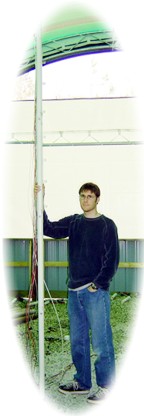
|
Measurement of Groundwater Flux in Fractured Media and Wells
| The Point Velocity Probe (PVP) was completely rethought to develop a version of the probe suitable for deployment in wells or open boreholes in fractured media. The new device is called the "In-Well Point Velocity Probe" or IWPVP. The probe has been extensively tested in laboratory tanks at KU and in the research labs at a TOTAL facility in Pau, France. Groundwater velocities determined in porous media well deployments at the C.F.B. Borden field site, and at a facility in France showed good agreement with velocities measured using the PVP. Flux distributions in fractured rock wells at the Edwards Airforce Base compared well with those determined by redox distributions and passive flux meter profiles. |
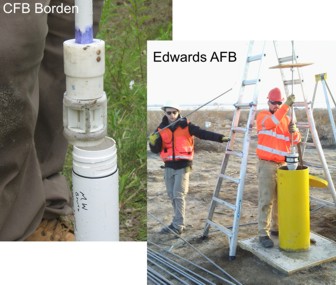 |
Monitoring flow in a passive treatment system
| The Point Velocity Probe (PVP) was modified to operate inside a cylindrical cartridge that was installed in an HRX Treatment Well. The HRX Well is installed in an aquifer horizontally in the direction of groundwwater flow. In passive operation the HRX Well is packed with highly permeable reactive media so that groundwater captured by the well is treated as it passes from the up-gradient end to the down-gradient end. This system is intended for use in low permeability aquifers, such as those comprising a notable silt fraction, so that the hydraulic conductivity contrast between the aquifer and the packed well is large, and the capture zone of the well is maximized. The PVP permitted near real-time assessments of flow through the HRX Well for verification that it was capturing the groundwater at the anticipated rates. The work was conducted at the Vandenberg Air Force Base in California, and both the PVP and HRX Well performed as designed. |
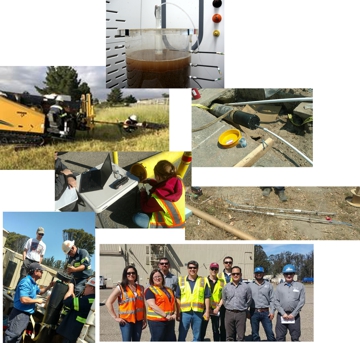 |
Groundwater Surface Water Interaction Research
| In an effort to expand the toolbox for quantifying water flow rates between groundwater and surface water, the point velocity probe concept (see "Direct Measurement of Groundwater Velocity", below) was adpated to measuring vertical flow rates at the streambed-streamwater interface. The novel probe was tested in the laboratory using a modified NeST aquifer simulator (Bowen et al., 2012) to simulate a streambed. It was then field tested at the Grindsted stream in Jutland, Denmark, where the flow rates were used to estimate contaminant mass discharges into the stream. The device was found to provide fast and accurate water velocity measurements in the sandy streambed of the study site. The probe was later applied to the measurement of infiltration rates in the passive treatment pond at Commerce, Oklahoma, operated by the University of Oklahoma. |
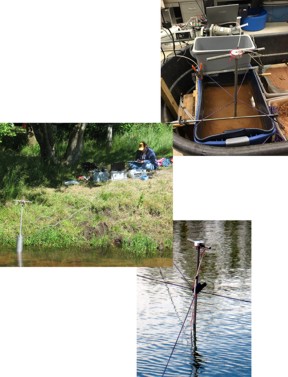 |
Granular Iron Research
|
The work began with investigations into the effects of sorption, competition, aging and and assessment of
the role of Fe2+ on the reduction of organic compounds by granular iron (Devlin et al., 1998).
An evaluation of Fe0 as an electron donor for denitrification followed (Devlin et al., 2000).
To preserve the iron surface from abrasion during batch tests, the GEM reactor was developed, in which the iron
is held stationary by a magnet while the solution is stirred (Devlin and Allin, 2005). This apparatus was
used to show that common anions in groundwater, at concentrations within the typical range, exert a notable effect
on iron reactivity (Devlin and Allin, 2005). Carbonate was paradoxically reported to be a reactivity enhancer
and a reactivity depressant in various studies by others. The GEM reactor was used to show that the complex behavior was
due in part to shifting stabilities of iron oxides and carbonates, depending on the carbonate solution concentration
(Bi et al., 2009). The limitations of mass transport on contaminant reduction rates was investigated
in sand-granular iron mixtures. It was found in experiments with both chlorinated solvents, and the much
faster reacting nitroaromatics, that more than 25% by weight sand caused notable declines in contaminant transformation
rates (Bi et al., 2009). Visualization tests indicated that the most reactive medium (highest rates per unit
mass of iron) are associated with about 15% sand, 85% iron mixtures by weight because the sand particles
promote better solution-iron surface contact by separating the grains from each other (Firdous and Devlin, in prep). The preceding work was based primarily on a simple conceptual model of reactions on the iron surface, i.e., that the surface can be treated as an homogeneous one with sorption occurring only to reactive sites. The development of a Kinetic Iron Model (KIM) provided a means of divorcing the contributions of sorption from those of reaction in contaminant disappearance rates (Devlin, 2009). The KIM permitted quantification of the isotherm parameters describing sorption to reactive sites as distinct from non-reacting sites, which could be evaluated from retarded transport (Bi et al., 2010). As iron ages, the rate of the reactions with organics seems to shift its dependency from a relatively small number of sites with fast electron transfer to a larger number of sites with slower electron transfer. This is indicated by declines in rate constants and increases in sorption capacities, as determined by the kinetic testing with the KIM (Bei, 2011). The importance of sorption raises the possibility that carbon on the iron surface is active in determining the surface reactivity. Raman analysis of aging iron grains confirms the changing character of carbon, and XRD suggests increasing carbon presence on the surface with increasing age, lending additional credence to the hypothesis that carbon is important (Firdous, 2013). |
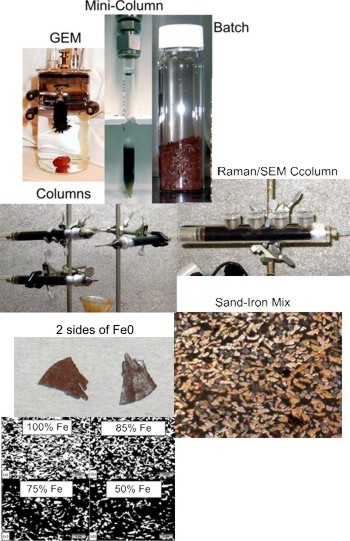 |
In situ denitrification
|
Nitrate is the most common groundwater contaminant in the world. It is introduced to groundwater mainly through
agricultural activity, and is widespread as a result. Removal of nitrate from groundwater is difficult to do at a
reasonable cost. Removal in situ is a promising alternative. This research began with an assessment of
stimulating in situ denitrification in an aquifer near the town of Baden, Ontario. A carbon source in the
form of acetate was shown to be a highly effective electron donor for denitrification throughout the aquifer (Devlin
et al., 2000). A pilot test ensued in which acetate was injected across the ambient flow direction in
weekly pulses that were allowed mix by dispersion as the acetate was transported toward a pumping municipal well.
A detailed assessment of the heterogeneity of the site was made prior to a pilot scale remediation test (Gierczak
et al., 2006). The system achieved complete nitrate removal within the test zone, with no noticeable
iron or sulfate reduction, and no nitrite production (Gierczak et al., 2007).
The success of the Baden experiments led to the work continuing at the municipal wells located outside Woodstock, Ontario, in collaboration with Dr. David Rudolph at the University of Waterloo and Oxford County, Ontario. The heterogeneity at the Woodstock site was found to be more pronounced than what had been observed at Baden, based on PVP velocity measurements and a natural gradient tracer test (Critchley et al., 2014). Groundwater velocities at the site were observed to be as high as 30 m/day. Nonetheless, laboratory testing of core material has shown that denitrifying bacteria are present throughout the aquifer. A pilot scale cross-injection test, similar to the Baden experiment, indicated acetate could stimulate denitrification at the site, but additional work is needed to optimize the process in the highest velocity layers. |
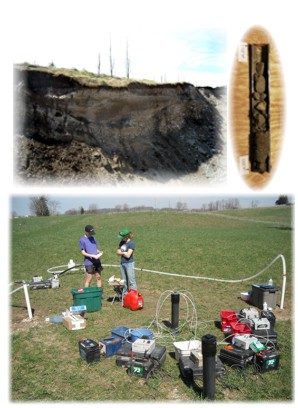 |
Research Highlights and Recognition
|
Farvolden Scholarship, 2023. Hanna Szydlowski was awarded a Farvolden Scholarship by the NGWA for her poster at the National Groundwater Week conference held in Las Vegas, Dec. 5-7, 2023. Her poster presented the results of a small Streambed Point Velocity Probe survey along Alder Creek, Ontario, as part of a larger project concerned with nutrient loadings to Lake Erie. The work was done in collaboration with Dr. David Rudolph at the University of Waterloo. Scott King and 2024 Darcy Lecturer Dr. Matt Becker seen to the left. |
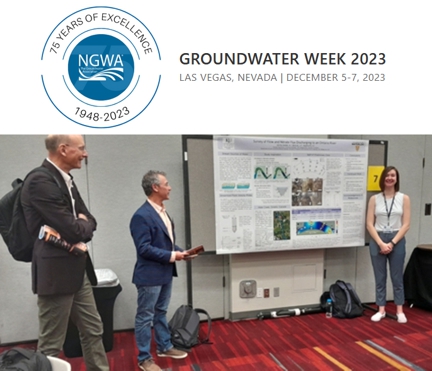
|
|
Farvolden Scholarships, 2022. Bryan Heyer and Logan French were each awarded Farvolden Scholarships by the NGWA for posters they presented at the National Groundwater Week conference held in Las Vegas, Dec. 6-8, 2022. Bryan's poster described the In-Well Point Velocity Probe adaptations to fractured rock wells and two applications of the technology in rock aquifers at Edward's Airforce Base and in Guelph, Ontario, Canada. Logan's project, which also won 2nd prize at the Kanasas Governor's Water Conference in Manhattan, KS, in November, 2022, in a related poster, described the characterization of flow beneath a northern Minnesota lake three-quarters filled with an organic rich muck. It was found that flow was diverted around the perimeter of the lake, mainly in a thin zone near the interface between the aquifer and the muck layer. Groundwater in this zone was apparently moving at velocities 50 times faster -or more - than in the surrounding aquifer. |
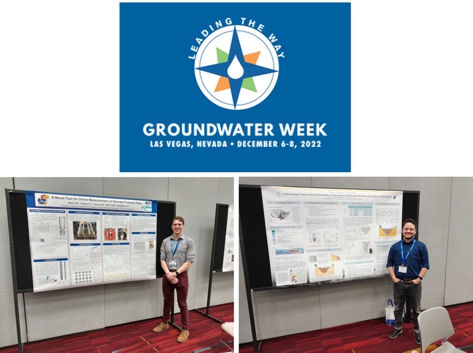
|
|
Farvolden Lecturer, 2022. J.F. Devlin was invited to give the Farvolden lecture at the University of Waterloo in October, 2022. The title of the lecture was, "The tools of understanding (because to solve a problem you must first understand it). The lecture reviewed the use of observation/experimentation, modelling, new tool development and the ensuing intuition gained to better understand various hydrogeological systems where contaminants were present. |
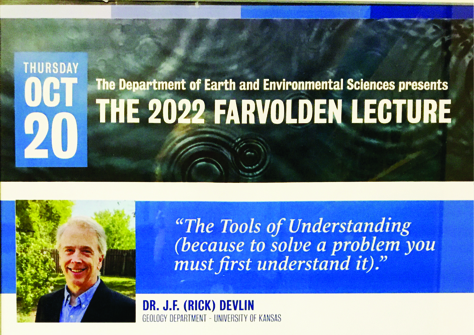
|
|
National research paper award winner. Bryan Heyer won third place in the 2021 National Student Research Paper competition award from Geosyntec. His paper dealt with the application of the IWPVP to fractured media. |
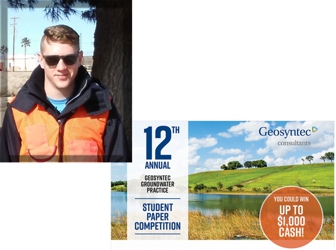
|
|
Groundwater Velocity book released. December, 2020: A new book entitled "Groundwater Velocity", which is based on the research conducted in this group and earlier work on the subject by others, was just released in the Groundwater Project series. The series features a growing number of books dealing with all aspects of hydrogeology, and all can be downloaded for free from the GWProject website. The Groundwater Velocity book in pdf form can be downloaded directly from this pdf-book link and a web-version of the book can be reached at this web-book link. |
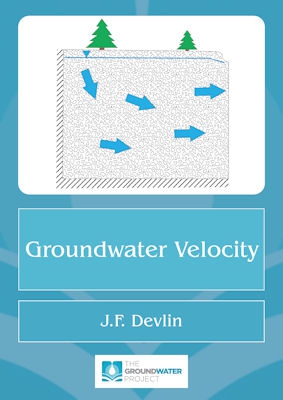
|
|
ESTCP awards project of the year. Allison Immel's (formerly Cormican) MS project was part of a larger project entitled "Demonstration and Validation of the Horizontal Reactive Media Treatment Well (HRX Well) for Managing Contaminant Plumes in Complex Geological Environment.s" that was awarded 'Project of the year' by SERDP-ESTCP for 2020. Her work examined the adaptation of a point velocity probe for monitoring flow through a passive, horizontal treatment well at the Vandenberg Air Force Base. A description of the project and the technical report can be downloaded from ESTCP Project ER-201631 |
|
|
KU hydrogeology makes the cover of GWMR. May, 2020: The spring issue of Groundwater Monitoring and Remediation features a cover showing Allison Cormican's PVP column tests. The image shows the various stages of column packing prior to experiments geared at assessing PVP design modifications on velocity measurement quality, and validation of K estimates from grain size analysis and permeametry for an engineered porous medium. The column was packed by Allison Cormican, and PVP was designed and printed with the assistance of Trevor Osorno. The cover photos were taken by Allison Cormican and arranged by J.F. Devlin. |
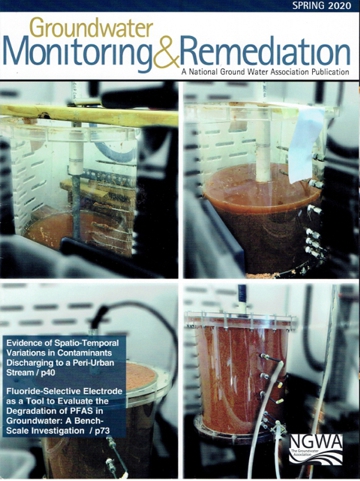
|
|
Point Velocity Probes go commercial. April, 2020: Solinst Canada has begun work with this research group to manufacture PVPs, IWPVPs and SBPVPs for commercial distribution. |
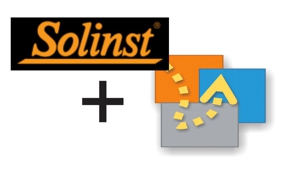
|
|
AIPG Award . May, 2020, Matt Jones was awarded an American Institute of Professional Geologists (AIPG) J. Siok Scholarship for his essay concerning the hydrogeology of Minnesota Lakes and the need for hydrogeologists with training in groundwater-surface water interaction techniques. His essay was closely related to his MS thesis topic, which focusses on the hydrogeology of Unnamed Lake, near Bemidji, MN. |
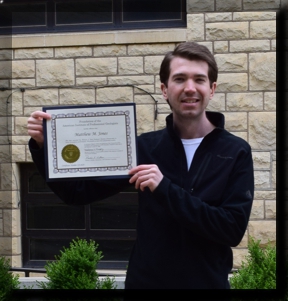
|
|
Chairing session at the fall 2107 GSA. J.F. Devlin and Mackenzie Cremeans co-chaired a session on groundwater- surface water interactions at the fall 2017 GSA meeting, October 22-25, in Seattle, WA. The session featured 25 oral presentations and 12 posters, with invited speakers including Dr. David Rudolph of the University of Waterloo, Dr. Poul Bjerg of the Technical Univeristy of Denmark, and Dr. Don Rosenberry of the USGS. |
|
|
National research paper award winner. Mackenzie Cremeans won the 2017 National Student Research Paper competition award from Geosyntec. Her paper dealt with the development and field testing of the Streambed Point Velocity Probe (SBPVP). |
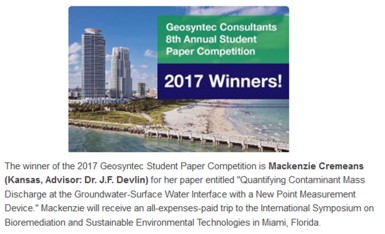
|
|
Governor's Water Conference Award Winners. Two of the three top student poster awards at 2106's Kansas Governor's Water Conference were presented to Trevor Osorno and Mackenzie Cremeans, both for work on point velocity probe research at KU. Trevor presented his poster on his recently completed Master's project in which he completed the development of an in-well point velocity probe. Trevor is now working on his doctoral thesis, which is concerned with advanced applications of direct velocity measurements. Mackenzie presented results from her doctoral research at a field site in Denmark. Her project concerns the quantification of water exchanges and mass fluxes of pollutants between surface water and groundwater. |
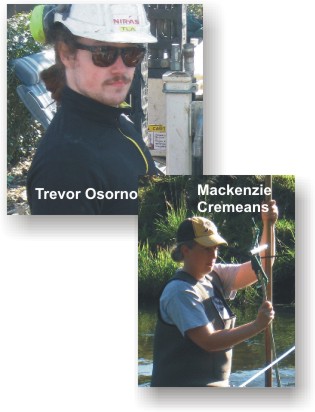
|
|
Hydrogeology Journal gives award. The Hydrogeology Journal selected the technical note HydrogeoSieveXL:an Excel-based tool to estimate hydraulic conductivity from grain-size analysis as one of its Editor's Choice articles for 2015. The articles are selected on the basis of several criteria including "outstanding science, innovative approach, potentially important conclusions, interesting field area or phenomenon, unusual topic, political/social/historical/philosophical interest". Each year 5 out of 130 articles are selected for the honor. The Excel spreadsheet with the program can be downloaded by selecting this link: HydrogeoSieveXL.xlsm |
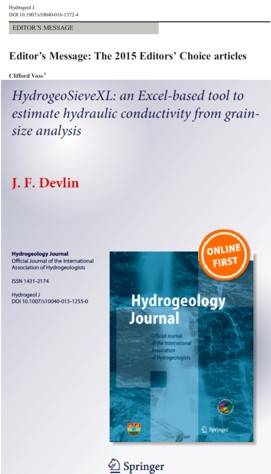
|
|
SERDP awards project of the year. Angela Eichler's MS project was part of a larger project entitled "Management of Contaminants Stored in Low Permeability Zones" that was awarded 'Project of the year' by SERDP for 2014. Her work examined diffusion coefficients in various noncohesive porous media and showed that they varied in a fashion that should be accounted for in matrix diffusion models. A description of the project and the technical report can be downloaded from SERDP Project ER-1740 |
|
|
EPA builds on our research. The EPA recently posted a spreadsheet program for calculating groundwater gradient magnitudes and directions building on work published by Devlin (2003). The EPA tool is primarily geared at solving the 3 point problem for wells monitored repeatedly in time. The manual and program can be downloaded from EPA-3PE. |
|
|
Sabatical in Denmark. Fall 2013 was spent at the Technical University of Denmark (DTU) working with Poul Bjerg and Philip Binning under an Otto Mønsted-Guest Professorship . Field work was undertaken to put PVPs into the ground beside a stream running through the town of Grinsted with the purpose of measuring groundwater velocities to the stream. Assisting with the field work were Associate Professor Ursula McKnight and Ph.D. student Anna Sonne. At this site, the PVPs indicated water was flowing to the stream at about 1 m/day. This was very similar in magnitude to the velocities implied by discharges into the stream determined by temperature gradients in the streambed. This work will be expanded between 2014 and 2017 in an ongoing collaborative project with DTU. |
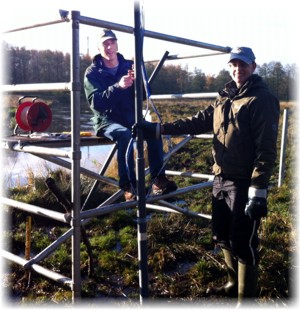
|
|
Poster wins first place. Brian Gibson presents a poster on the development and testing of point velocity probes capable to detecting and measuring groundwater velocity from any direction without prior knowledge of the flow system. This poster won first place out of over 20 posters presented at the G-Hawker Symposium held at the Alumni Center of the University of Kansas September 22, 2012. |
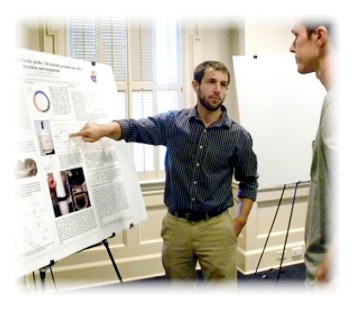
|
|
Research papers win awards. Three graduate student entries from this group placed first, second, and third in the Geosyntec National Student Research Competition in 2012. Peter Schillig won first place for his work at the Woodstock site, Ontario, Canada, where he showed groundwater flow in glacial outwash sediments was affected by a bioremediation program. That work was done in conjuction with Dr. David Rudolph and his graduate students Kate Critchley and Jane Shaw at the University of Waterloo, and was funded in large part by Oxford County, Ontario. Angela Eichler won second place for her work measuring diffusion coefficients in permeable materials such as silt and sand. That work was conducted as part of a larger project managed by Tom Sale at the Colorado State Universty and funded by SERDP. Rubina Firdous won third place for her work relating chemical kinetic parameters from bench-scale experiments of granular iron reactions to microscopic changes on the iron surface. Her work was supported by Fullbright and NSF. |
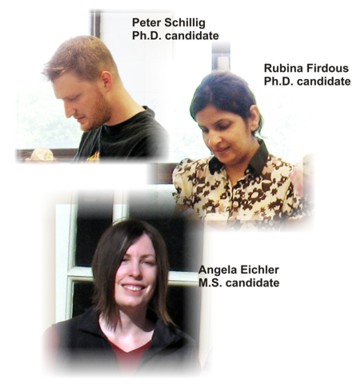
|
|
Prototype PVPs. The first printed plastic PVPs came off the prototype printer early in 2011. KevinWalter produced the first units using Google Sketchup and the hardware in Dr. Dan Hirmas' lab in the Geography Dept. The first designs were aimed at measuring horizontal flow only, and the PVPs were intended to be dedicated as single probes per borehole. Kevin has since gone on to design a multilevel version of the probes, and the most recent prototypes will have the ability to measure vertical and horizontal flow. |
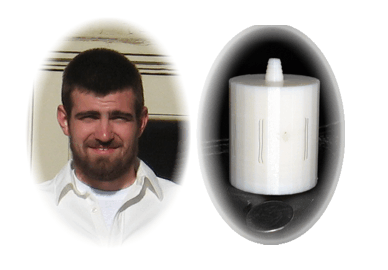
|
|
G-Hawker Poster Award Winners. Undergraduate Elisheva Patterson, and graduate student Peter Schillig, shown at right, were awarded the top two places for their research presentations in the G-Hawker Symposium, held at the University of Kansas in October, 2007. The presentations dealt with complimentary studies in the field (Schillig) and laboratory (Patterson) demonstrating a relationship between ground penetrating radar (GPR) wave velocities and microbial activity in biostimulated sand. This research has application in the bioremediation industry and in the monitoring of natural attenuation of pollutant plumes. |
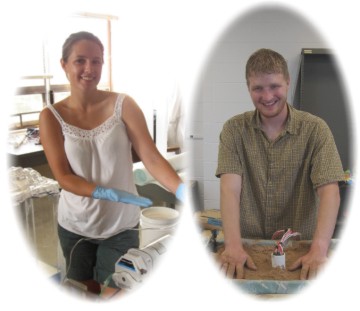
|
|
Best Student Paper at AGU. With the rise of permeable reactive barriers for groundwater remediation, questions need to be asked concerning how long they last and what controls their performance. It is frequently noted that rates of pollutant transformation in laboratory tests do not match rates observed in the field. In this work it is hypothesized that residence time in the reactive zone of an aquifer undergoing bioremediation is affected by the microbial activity there. Peter Schillig performed his Masters research on this topic for which he was awarded best student paper at the AGU Joint Assembly, Acapulco, Mexico, in May, 2007. Peter was also awarded the prestigious Self Fellowship to continue his research at the doctoral level at KU. In 2009 he was awarded a GSA grant to conduct laboratory column tests aimed at linking aquifer texture to microbial hot spots. At right Peter poses beside the grill of a Dept. SUV containing feathers from a turkey vulture he bagged in flight. |
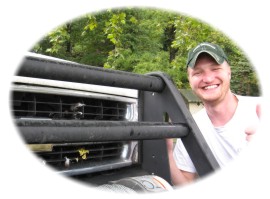
|
|
AEG Student Paper Award Winner. Observed reaction rates of organics with granular iron depends on both the quantity sorbed and the surface reaction rate. Similar rates might be observed for the two distinct cases in which either sorption is large but surface reactions are low, or sorption is low but surface reaction rates are high. Unfortunately, uniquely calculating the sorption and reaction parameters necessary to model such scenarios is difficult for reacting species. The literature reports only one extraction based method to accomplish this separation of processes. However, a new method, involving combined column and batch tests, was tested by Melissa Marietta with promising results (undergraduate thesis work) for three nitroaromatic compounds. The work won her the AEG student paper award, 2005. At right Melissa presents her work to the AEG membership after winning the award. |
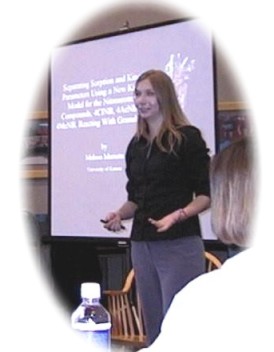
|
Selected Projects at a Glance
| Research Topic | Graduate Student
Undergraduate (U) or Collaborators (C) |
Status | Completion |
Survey of flow and nitrate flux to an Ontario River |
Hanna Szydlowski | M.S. Research, in progress
NGWA Farvolden Scholarship winner, Groundwater Week poster, 2023 |
Fall 2024 |
| M.S. Hydrogeology of Unnamed
Lake, Bemidji, MN |
Logan French | M.S. Research, in progress
NGWA Farvolden Scholarship winner, Groundwater Week poster, 2022 Awarded second place in the Governor's Water Conference poster competition, Manhatten, KS, 2022. |
Winter 2024 |
| B.S. SBPVP testing |
Gavin Stockdale (U) | Research Assistant, 2021 | Fall 2021 |
| M.S.: Hydrogeology of
Unnamed Lake, Bemidji, MN |
Matt Jones | M.S. Research Incomplete
Awarded the 2020 William J. Siok Graduate Scholarship from the Foundation of the American Institute of Professional Geologists (AIPG) |
Winter, 2024 |
| M.S.: Direct velocity
measurement in fractured media Ph.D.: TBA |
Bryan Heyer | M.S. Research
NGWA Farvolden Scholarship winner, Groundwater Week poster, 2022 Geosyntec student paper competition winner,third place, 2021 1) Heyer, B.R., Osorno, T.C., Devlin, J.F. 2021. Laboratory testing of real-time flux measurements in fractured media. Journal of Hydrology, accepted. 2) Heyer, B.R., Osorno, T.C., Carrera, B.A., Mok, C.M.W., Devlin, J.F. 2022. Water flux profiling in fractured rock boreholes with an In-Well Point Velocity Probe (IWPVP). Journal of Hydrology, 613, 128383. Ph.D Research in progress |
M.S. Spring 2021 Ph.D. Spring 2025 |
| M.S.: Assessing Passive In Situ
Reactive Media Hydraulics by Direct Velocity Measurements
In the Laboratory and Field |
Allison Corminan | M.S. Research Complete
Experiment on cover of GWMR Journal, Spring, 2020 ESTCP project of the year, 2020 1) Cormican, A., Devlin, J.F., Divine, C. 2020. Grain size analysis and permeametry for estimating hydraulic conductivity in engineered porous media. Groundwater Monitoring and Remediation, v. 40, no. 2, 65-72. 2) Cormican, A., Devlin, J.F., Osorno, T.C., and Divine,C. 2021. Design, Testing, and Implementation of a Real-Time System for Monitoring Flow in Horizontal Wells. Journal of Contaminant Hydrology v. 238, 103772. |
Spring 2020 |
| M.S.: Pilot test of a horizontal treatment
well |
Billy Hodge | M.S. Research Incomplete | Fall, 2018 |
| B.S.: SBPVP modifications for horizontal
hyporheic flow and sampling |
Ayla Mellott (U) | B.S. Honors Thesis Complete | Spring, 2019 |
| B.S.: Vertical water flow behavior
through PVP packing brushes |
Don Jordan (U) | Research Assistant, 2019 | Spring, 2019 |
| M.S.: Development and Testing of an
In-well Point Velocity Probe for Preliminary Site Characterization
Ph.D. Detailed aquifer characterization with direct measurements of groundwater velocity |
Trevor Osorno | M.S. Research Complete
Top 3 student poster award winner Kansas Governor's Water conference, 2016 Awarded honors for M.S. work 1) Osorno, T., Devlin, J.F. 2018. An in-well point velocity probe for the rapid characterization of groundwater velocity at the centimeter-scale. Journal of Hydrology, v. 557, 539-546. 2) Osorno, T.C., Devlin, J.F., Bohling, G. 2022. Geostatistics of the Borden aquifer: High-Resolution Characterization using Direct Groundwater Velocity Measurements. Water Resources Research, v. 58, e2020WR029034. https://doi.org/10.1029/2020WR029034. Ph.D Research in progress |
M.S. Fall 2017 Ph.D. Spring 2022 |
| Development of Tools and Methods for the Characterization of the Groundwater-SurfaceWater Interface | Mackenzie Cremeans | Ph.D. Research Complete
Geosyntec student paper competition winner, 2017 IAH Student Membership Award (nationally awarded yearly to 5 students for excellence) Top 3 student poster award winner Kansas Governor's Water conference, 2016 Awarded Self Fellowship for Ph.D. studies, Fall, 2014 1) Cremeans, M., Devlin, J.F. 2017. Validation of a new device to quantify groundwater-surface water exchange. Journal of Contaminant Hydrology, 206, 75-80. 2) Cremeans, M., Devlin, J.F., McKnight, U., Bjerg, P. 2018. Application of new point measurement device to quantify groundwater- surface water interactions. Journal of Contaminant Hydrology, v. 211, 85-93. 3) Cremeans, M.M., Devlin, J.F., Osorno, T.C., Nairn, R.W. 2019. Assessment of Bed Hydraulics and Metals Loadings in a Passive Vertical Flow Bioreactor in Commerce, Oklahoma. Groundwater Monitoring and Remediation, doi: 10.1111/gwmr.12337. |
Fall 2019 |
| Development and assessment of a fully 360o, 3D PVP | Brian Gibson | M.S. Research Incomplete
First place presentation at the G-Hawker Symposium, University of Kansas Dept. of Geology, Sept., 2012 1) Gibson, B., Devlin, J.F. 2018. Laboratory validation of a point velocity probe for measuring horizontal flow from any direction. Journal of Contaminant Hydrology, v. 208, 10-16. |
Fall 2013 |
| Measuring groundwater velocity in coarse-grained deposits | Kevin Walters | M.S. Research Incomplete 1) Walter, K., Devlin, J.F. 2017. Application of 3D printing to the manufacturing of groundwater velocity probes (PVPs). Groundwater Monitoring and Remediation, doi: 10.1111/gwmr.12210. |
Fall 2012 |
| Diffusion in heterogeneous porous media | Angela Eichler | M.S. Research Incomplete
Second place in the Geosyntec-sponsored national Student Research Contest, April, 2012 Co-winner of SERDP's 'project of the year', 2014 |
Fall, 2012 |
| Scale dependent processes affecting granular iron reactivity | Rubina Firdous | Ph.D. Research Complete
Third place in the Geosyntec-sponsored national Student Research Contest, April, 2012 1) Bi, E., Devlin, J.F., Huang, B., Firdous, R. 2010. Transport and kinetic studies to characterize reactive and non-reactive sites on granular iron. Environmental Science and Technology, v. 44, no. 14, 5564-5569. 2) Firdous, R., Devlin, J.F. 2014. Consideration of grain packing in granular iron treatability studies. Journal of Contaminant Hydrology v. 164, 230-239. 3) Firdous, R., Devlin, J.F. 2014. BEARKIMPE: A VBA Excel program for characterizing granular iron in treatability studies. Computers & Geosciences, v. 63, 54-61. 4) Firdous, R.,Devlin, J.F.. 2018. Surface carbon influences on the reductive transformation of TCE in the presence of granular iron. Journal of Hazardous Materials, v. 347, 31-38. |
Ph.D. Fall 2013 |
| M.S.: Microbial Activity and its Effects on
Groundwater Velocity in a Contaminated Aquifer
Ph.D. Localizing microbial growth in heterogeneous aquifers (tentative) |
Peter Schillig | M.S. Research Complete
Ph.D. Research Complete Winner of Hayworth Award for outstanding graduate work at KU, Spring, 2013 Awarded honors for Ph.D. work, fall, 2012 First place in the Geosyntec-sponsored national Student Research Contest, April, 2012 Awarded honors for M.Sc. work, spring, 2008 Awarded Self Fellowship for Ph.D. studies, Fall, 2007 First place presentation at the G-Hawker Symposium, University of Kansas Dept. of Geology, Oct., 2007 Best Student Paper at AGU Joint Assembly, May, 2007 1) Schillig, P.C., Tsoflias, G.P., Roberts, J.A., Patterson, E.M., Devlin, J.F. 2010. Ground-penetrating radar observations of enhanced biological activity in a sandbox reactor, Journal of Geophysical Research, v. 115, G00G10, doi:10.1029/2009JG001151. 2) Schillig, P., Devlin, J.F., McGlashan, M., Tsoflias, G., Roberts, J.A. 2011. Transient heterogeneity in an aquifer undergoing bioremediation of hydrocarbons. Ground Water, v. 49, no. 2, 184-196. 3) Schillig, P., Devlin, J.F., McElwee, C.D. Walter, K. and Gibson, B. 2014. Assessment of density-induced tracer movement in groundwater velocity measurements with point velocity probes (PVPs). Ground Water Monitoring and Remediation, v. 34, no. 4, 44-50. 4) Schillig, P.C., Devlin, J.F., Rudolph, D. 2016. Upscaling point measurements of groundwater velocity for enhanced site characterization in a glacial outwash aquifer. Groundwater, v. 54, no. 3, 394-405. 5) Devlin, J.F., Schillig, P.C. 2017. HydrogeoEstimatorXL: An Excel-based tool for estimating hydraulic gradient magnitude and direction. Technical Note in the Hydrogeology Journal DOI 10.1007/s10040-016-1518-4. |
M.S. Feb. 2008
Ph.D. Fall 2012 |
| Diffusion in saturated porous media: a review | James Lyons | M.S. Project Complete | M.S. Spring 2013 |
| Effect of mixed anions
(HCO3- - SO42-, ClO4-
- SO42-) on Fe0 reactivity |
Hillary Kelly (U) | B.S. Research Complete
1) Kelly, H.S., Devlin, J.F. 2011. Effect of mixed anions (HCO3- - SO42-, ClO4- - SO42-) on Fe0 reactivity. Presented at the University of Kansas-Haskell Indian Nations University Undergraduate Research Symposium, Haskell University, Lawrence, KS, April 26. |
B.S. Fall 2011 |
| B.S.: Assessment of three mixing methods for
studying reaction kinetics with granular iron
M.S.: The Effect of Point Velocity Probe Size on Groundwater Velocity Estimation in Noncohesive Sediments |
Natalie Burris | B.S. Thesis Complete, manuscript published as:
1) Garven, N.L., Devlin, J.F. 2006. Minimizing Mass Transfer Effects in Granular Iron Batch Tests Using GEM Reactors. J. Envir. Eng. 132, 1673. M.S. Research complete |
B.S. Spring 2005
M.S. Fall, 2014 |
| Separating the kinetic and sorption parameters of mixed chlorinated solvents in contact with granular iron | Huang Bei | Ph.D. Research Complete
Thesis awarded honors 1) Bi, E., Devlin, J.F., Huang, B., Firdous, R. 2010. Transport and kinetic studies to characterize reactive and non-reactive sites on granular iron. Environmental Science and Technology, v. 44, no. 14, 5564-5569. Additional articles in progress |
Spring, 2011 |
| B.S.: Investigation of the effects of anion mixtures
on the reactivity of granular iron
M.S.: Characterization of a Dipole Flow System Using Point Velocity Probes |
Ian Bowen | B.S. Complete:
1) Bi, E., Bowen, I., Devlin, J.F. 2009. Effect of Mixed Anions (HCO3--SO42- - ClO4-) on Fe0 Reactivity. Environmental Science and Technology v. 43, no. 15, 5975-5981. M.S. Complete 1) Bowen, I.R., Devlin, J.F., Schillig, P.C. (2012). Design and testing of a convenient benchtop sandbox for controlled flow experiments. For Ground Water Monitoring and Remediation. 2) Devlin, J.F., Schillig, P.C., Bowen, I., Rudolph, D.L., Thomson, N.R., Tsoflias, G.P., Roberts, J.A. 2011. Applications and implications of direct groundwater velocity measurement at the centimetre scale. GQ10: Groundwater Quality Management in a Rapidly Changing World, Proc. 7th International Groundwater Quality Conference, Zurich, Switzerland, 13-18 June 2010, 50-53. 3) Devlin, J.F., Schillig, P.C., Bowen, I., Critchley, C.E., Rudolph, D.L., Thomson, N.R., Tsoflias,G.P., Roberts, J.A. 2012. Applications and implications of direct groundwater velocity measurement at the centimetre scale, Journal of Contaminant Hydrolology, v. 127, doi:10.1016/j.jconhyd.2011.06.007, 3-14. |
B.S. Spring 2008
M.S. Fall 2010 |
| Accuracy and angular range of mini-PVPs for groundwater velocity measurement in 3D | Alek McElroy (U) | Research Assistant, Spring, 2010 | Spring 2010 |
| 1)Optimizing iron/sand mixtures for TCE removal from water
2) Investigating effects of mixed anions on Fe0 reactivity 3) Use of the KIM to characterize reactive and non-reactive sites on granular iron 4) A novel interactive teaching tool for graduate studies |
Erping Bi (C) | Post doctoral Research Complete
1) Bi, E., Devlin, J.F., Huang, B., Firdous, R. (in press). Transport and kinetic studies to characterize reactive and non-reactive sites on granular iron. Submitted to Environmental Science and Technology. 2) Bi, E., Bowen, I., Devlin, J.F. 2009. Effect of Mixed Anions (HCO3- - SO42- - ClO4-) on Fe0 Reactivity. Environmental Science and Technology v. 43, no. 15, 5975-5981. 3) Bi, E., Devlin, J.F., Huang, B. 2009. Effects of mixing granular iron with sand on the kinetics of trichloroethylene reduction. Ground Water Monitoring and Remediation, v. 29, no. 2, 56-62. |
Fall 2008 |
| Assessment of GPR response to microbial growth | Elisheva Patterson (U) | B.S. Complete
Second place presentation at the G-Hawker Symposium, University of Kansas Dept. of Geology, Oct., 2007 1) Schillig, P.C., Tsoflias, G.P., Roberts, J.A., Patterson, E.M., Devlin, J.F. 2010. Ground-penetrating radar observations of enhanced biological activity in a sandbox reactor. Journal of Geophysical Research, v. 115, G00G10, doi:10.1029/2009JG001151. |
Spring 2009 |
| Detailed assessment of groundwater velocities on the surface of a point velocity probe | Neil Kinnebrew (U) | Research Assistant, Fall 2006 | Spring 2007 |
| Estimating groundwater velocity with a point velocity probe | Shawn Showman (U) | Research Assistant, Summer 2006 | Summer 2006 |
| Using grid distortion to simulate the effects of heterogeneity on modeled plumes | Kathy Baker | M.S. Project complete | Mar. 2008 |
| Permeability versus Surface Reactivity on the Longevity of Granular Iron Reactive Barriers | Michelle Dambacher | M.S. thesis complete, manuscripts in progress
Thesis awarded honors |
Fall 2005 |
| Separating sorption and kinetic paramaters using a new kinetic model for the nitroaromatic compounds 4ClNB, 4AcNB and 4MeNB reacting with granular iron | Melissa Marietta (U) | B.S. thesis complete
Winner of the 2005 AEG student paper competition Manuscript published as: 1) Marietta, M.L., Devlin, J.F. 2005. Bringing Groundwater Quality Research to the Watershed Scale (Proceedings of GQ2004, the 4th International Groundwater Quality Conference, held at Waterloo, Canada, July 2004). IAHS Publ. 297, 2005. |
Spring 2005 |
| Development of a Point Groundwater Velocity Probe | Walid Labaky | Ph.D. Research Complete
Nominated for the Pearson Award Manuscript published as: 1) Labaky, W., Devlin, J.F., Gillham, R.W. 2007. A probe for measuring groundwater velocity at the centimetre scale. Environmental Science and Technology, v. 41, no. 24, 8453-8458. 2) Labaky, W., Devlin, J.F., Gillham, R.W. 2009. Field comparison of the point velocity probe with other groundwater velocity measurement methods, Water Resour. Res., 45, W00D30, doi:10.1029/2008WR007066. |
Sept., 2004 |
| Assessing Granular Iron Reactivity | Jessica Leuty (U) | Undergraduate summer research 2003 | 2003 |
| Effect of Iron Dilution (with non-reactive material) in Reactive Barriers | Janet Patchen (U) | Undergraduate summer research 2003:
1) Devlin, J.F., Patchen, J. 2004. The effect of diluting granular iron with a non-reactive porous medium on contaminant transformation rates. Presented at the 5th Joint Conference of the IAH-CNC and the Canadian Geotechnical Society (CGS), Quebec City, October 24-27. |
2003 |
| In situ denitrification of an aquifer near a municipal water supply well | Richard Gierczak | M.S. Research Complete
Nominated for the Dean of Science Award Manuscripts published as: 1) Gierczak, R., Devlin, J.F., Rudolph, D. 2006. Combined Use of Laboratory and In situ Hydraulic Testing to Predict Preferred Flow Paths of Solutions Injected Into an Aquifer. Journal of Contaminant Hydrology, v. 82, 75-98. 2) Gierczak, R., Devlin, J.F., Rudolph, D. 2007. Field test of a nutrient injection wall for stimulating in situ denitrification near a municipal water supply well. Journal of Contaminant Hydrology v. 89, 48-70. |
Aug., 2002 |
| Saturation kinetics of organics reacting with granular iron | Christine March | M.S. Research Complete, manuscript published as:
Devlin, J.F. March, C. 2003. Investigating the kinetic limitations of granular iron over a large range of 4-chloronitrobenzene concentrations. Presented at the 225th American Chemical Society Meeting, New Orleans, LA, March 23. |
Feb., 2002 |
| Sorption of Anilines to Master Builder's Iron | Mike Smith | M.S. Research Complete, manuscript in progress.
Nominated for the Dean of Science Award |
Feb. 2001 |
| Effect of geochemical composition of water on granular iron reactivity | Kevin Allin | M.S. thesis complete
Manuscript published as: 1) Devlin, J.F., Allin, K.O. 2005. The effects of major anions on the reactivity of granular iron using a glass encased magnet (GEM) batch reactor. Environmental Science and Technology, v. 39, no. 6, 1868-1874. |
Jun., 2000 |
| Treatment of mixed contaminant plumes with in situ sequential treatment | Denis Katic, Mary Morken, Jim Barker (C) | M.S. Research Complete
Manuscript published as: 1) Devlin, J.F., D. Katic, McMaster, M., Barker, J.F. 2002. Evaluating natural attenuation in a controlled field experiment by mass balances, flux fences and snapshots: a comparison of results. Groundwater Quality Natural and Enhanced Restoration of Groundwater Pollution, S.F. Thornton and S. Oswald eds., IAHS Publication no. 275. 2) Devlin, J.F., Katic, D., Barker, J.F. 2004. In situ sequenced bioremediation of mixed contaminants in groundwater. Journal of Contaminant Hydrology, v. 69, no. 3-4, 233-261. 3) Morkin, M., Devlin, J.F., Barker, J.F., Butler, B.J. 2000. In situ sequential treatment of a mixed contaminant plume. Journal of Contaminant Hydrology, v. 45, 283-302. |
2001 |
